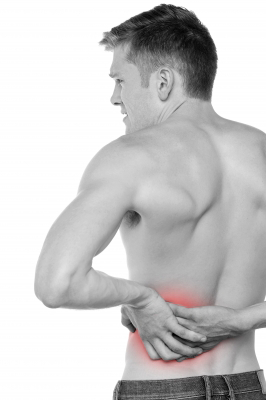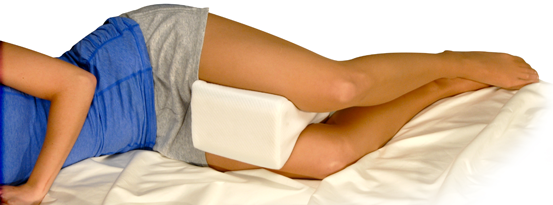Sleeping with Sciatica, Spinal Stenosis and Herniated Discs
Contour Living on 31st Jul 2013
 Lower Back Pain – Almost everyone will experience lower back pain and associated pains in the buttocks, legs and sometimes burning, tingling sensations and numbness in the legs. Common causes of this lower back pain include spinal stenosis, herniated discs, and sciatica, and these conditions can all be exasperated while sleeping.
Lower Back Pain – Almost everyone will experience lower back pain and associated pains in the buttocks, legs and sometimes burning, tingling sensations and numbness in the legs. Common causes of this lower back pain include spinal stenosis, herniated discs, and sciatica, and these conditions can all be exasperated while sleeping.
Sometimes, these conditions are caused by injury, over-exertion and other physical activities involving the spine. More often, age and normal wear contributes to lower back pain. As our bodies age, muscles, joints and bones all change, often affecting flexibility and performance. Sciatica, spinal stenosis and herniated discs fall into this category.
Many people are affected by osteoarthritis and osteoporosis. These are longer term conditions that can gradually diminish the overall performance of the body. Treatments for all conditions vary widely; some may include surgery, physical therapies and rehabilitation, and a variety of non-surgical treatments.
People who suffer from and seeking treatment for sciatica, disc herniations, spinal stenosis and low back pain should use the Contour Leg Pillow to help place the lower spine in proper alignment and posture.
The preferred sleeping position for back posture and alignment is on your side; however, this can present some associated problems. Side sleeping can aggravate low back problems, including sciatica, disc herniation, ruptured and bulging discs and other causes of low back pain.
Typically when side sleeping your legs do not stay aligned vertically, meaning that the top leg usually drops forward slightly and down, causing your pelvis to rotate. This rotation of your pelvic causes several other problems:
- Pressure is placed on the sacroiliac joint or SI joint which can lead to sciatica pain.
- Second, when your top leg causes your pelvis to rotate, it puts a slight twisting force on your lower vertebrae and discs from the lumbar area up to the thoracic region of your spine (middle back). This twisting force can distort your spinal discs and prevent full recovery and re-hydration. For people with herniated discs or ruptured discs, this can be a critical impediment to healing
- This twisting also causes your back muscles to tighten and stress on spinal ligaments
- Fourth, any one with Spinal stenosis is going to be much more sensitive improper alignment and stability when sleeping.
 The patented Contour Leg Pillow is a very simple way to immediately stabilize your pelvis and reduce the stress and twisting force on your sacroiliac joints, herniated discs, muscles and ligaments. It’s amazing how much this simple pillow can help sciatica and lower back pain.
The patented Contour Leg Pillow is a very simple way to immediately stabilize your pelvis and reduce the stress and twisting force on your sacroiliac joints, herniated discs, muscles and ligaments. It’s amazing how much this simple pillow can help sciatica and lower back pain.
Some lower back pain and associated conditions that can result or be come worse from side sleeping:
Sciatica Pain: Causes and Symptoms
Sciatica isn’t a specific condition, but rather a term used to describe symptoms of other lower back conditions. This can include bulging and herniated discs, etc. Sciatica pain is associated with the sciatic nerve which runs down the upper and lower back, through the buttocks, and down both legs. The sciatic nerve is the largest nerve in the human body.
Irritation to the sciatic nerve can cause sciatica which can cause pain and discomfort anywhere on the nerve. Frequently, sciatica results in lower back pain, burning, tingling, numbness and pain in the legs and buttocks.
Side sleeping can aggravate sciatica pain. Typically when side sleeping, your legs do not stay aligned vertically, meaning that the top leg usually drops forward and down, causing your pelvis to rotate.
This places strain on the sacroiliac joint or “SI Joint” and can cause compression of the sciatic nerve. Compression causes it to become irritated and inflamed. This usually causes pain in the lower back or pain that radiates through the buttocks and down your leg. This can also take the form of an intermittent shooting pain. Sciatic pain can radiate to the foot and toes depending on which nerve is compressed. Sciatic pain usually only affects one side of the body at a time.
Sciatica symptoms often include:
- Pain the buttocks or back of your leg that often becomes worse when sitting.
- Burning or tingling sensation down your leg
- Weakness or numbness in the leg or foot.
- A constant, persistent pain on one side or your rear
- A shooting pain making it difficult to stand.
Disc Herniations and spinal stenosis can further aggravate sciatic pain and low back pain or Lumbar pain.
Herniated disc causes and symptoms
Herniated discs (sometimes call bulging discs, slipped discs) are a medical condition affecting the spine. A herniation is a protrusion through an abnormal bodily opening and a disc herniation refers to a tear in the outer ring of an intervertebral disc and allowing the soft, inner portion to “bulge out”. This ‘tear” can be very painful, especially considering the proximity of the many spinal nerve endings in the areas of discs.
Many normal activities can aggravate the condition of your discs including sleeping on your side. With age and wear the spinal discs often become less elastic. As a result they can rupture. When the disc ruptures, a portion of the spinal disc pushes outside of its normal boundary. When a herniated disc bulges out from between the vertebrae, the spinal nerves and spinal cord can become pinched causing low back pain or pains that can radiate to other parts of your body.
When sleeping with herniated discs, it is extremely important that the lower spine, vertebra discs and ligaments, be aligned and placed in a neutral posture without the common twisting forces of your legs applied to them. The Contour Leg Pillow is a very simple way to immediately improve alignment and reducing the twisting force.
Lumbar Spinal Stenosis Causes and symptoms
Spinal Stenosis has been referred to as the “Silent Epidemic”. It is a narrowing of the spinal canal, which can pinch the spinal cord and nerves, and lead to persistent pain in the buttocks, cramping, limping, numbness in the lower extremities and lead to decreased physical activity ability. A common cause is bone damage related to osteoarthritis.
Symptoms are most common in people over the age of 60. However, some degree of spinal stenosis is occurring in the entire adult population.
Due to the narrowing of the spinal canal, it is even more important for people over the age of 40 to have proper sleep posture. The Contour Leg pillow provides improved alignment of the lumbar and sacroiliac regions of your spine when sleeping in the side position. It is simple to use and the long term benefits can be enormous.
For an in-depth description of spinal stenosis with illustrations showing the condition.
